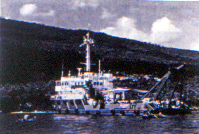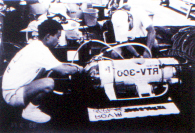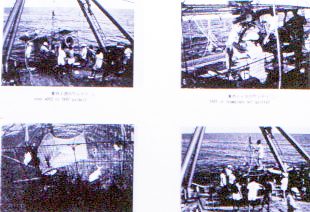Recollections of the Past 30 years pursuing Coelacanths
Jerome Hamlin, creator dinofish.com
No other coelacanths were caught during this visit, so we never used the acoustical trackers. Instead we searched for the trap and line with the same grappling gear I had used for the cage search a year earlier. But this search was also fruitless. I had the added obligation to inform the C.C.C. of a possible stray line in one of the coelacanth areas in case the submersible went down there. I accomplished the final objective of filling the large transporter tank stored at the consulate warehouse with container after container of seawater, brought in by pickup trucks and hooking it up to our original water cooler and other life support gear for the purpose of having it ready for the next accidental bycatch- instead of using a decompression cage. If the fish recovered in the transporter it could either be shipped out or released back into the sea in good shape. I explained to a very smart Comorian friend how to operate the system. Then we returned to the U.S to await what I presumed would be the successful Japanese expedition in the fall /winter of '89/'90. The Toba Aquarium Coelacanth Collecting and Research Expedition was like nothing the Comoros had ever seen before. A huge mothership from Japan appeared off of Grand Comoro, bringing specialized Phillipno handline fishermen, especially designed coelacanth traps, a pressurized containment transporter, and one or more remotely operated underwater vehicles (ROV's., ) along with technicians and marine biologists. Every angle seemed to be covered- but one.



With funding of over a million dollars, some from Mitsubishi, the Toba Aquarium Coelacanth collecting espedition arrived in the Comoros in fall '89. Nothing on this scale had ever been attempted before.
While currents were making the operation of the ROV difficult, some images of coelacanths were said to have been obtained. The Phillipino handline fishermen were not having much luck. Some Comorians caught a coelacanth while the expedition was there. They brought it still alive to the ship towing it behind their canoe, but the Japanese declined to bring it on board, preferring to obtain one with their own advanced techniques, and also possibly fearing it would die on board with the subsequent bad PR. But it was the traps that really backfired. Unluckily for the Japanese, the German submersible crew was back on the scene, at the same time with an upgraded submarine called Jago. The German team spotting one of the traps prepared a sign with the syntactically odd wording: "Coelacanths- let them where they are!" Pictures of this hit the news and the Expedition was kaput from the bad press. About this time, having installed my first fax machine, I received an invite from the Japanese Expedition to join them on their mothership! I thought better of it. Mitsubishi withdrew it's support and the whole operation collapsed. All that was left were bits and pieces of the project that had been brought ashore: the detritus of hubris.
